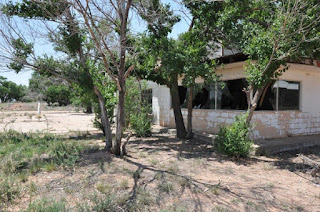 |
| The first and last hotel in Texas |
Glenrio was established in 1903 and named Rock Island when the Chicago, Rock Island and Pacific railroad laid tracks through the area. Nobody really knows how the name Glenrio was chosen to replace Rock Island several years later as the it is derived from the English word "valley" and the Spanish word for river - the town is in neither a valley nor along a river.
 |
| The long abandoned courtyard motel |
In 1905, farmers and small ranchers settled in the area on 150 acre plots and a year later, the railroad established a station on the Texas side of the town. Soon afterwards, a post office was opened on the New Mexico side even though the mail was delivered to the rail station on the Texas side.
By 1920, Glenrio had a hotel (built on the Texas border and billed as the "First and Last Hotel in Texas), a land office, a hardware store, and several grocery stores. Interestingly, the Texas side had several gas stations, but being in Deaf Smith County where no alcohol was permitted, there were no bars. The New Mexico side had no gas stations because gas taxes in that state were so high, but they did have a number of bars because alcohol was not outlawed. This arrangement led to a long debated battle between Texas and New Mexico because both states wanted the tax revenue.
In 1937, Route 66 was built through Glenrio and the town quickly grew as it became a popular stopping place for travelers. A "welcome station" was built near the state line and a post office was established on the Texas side. In 1938, John Steinbeck's Grapes of Wrath was filmed for three weeks in the town and everyone was sure the town would soon be a city.
 |
| The remains of a former filling station |
By 1990, the post office was closed and Glenrio was a town haunted by its former glory. The 2000 census showed 5 people living in the area, but none in the town itself. Today, there are only a few abandoned buildings, mere shadows of their former selves as they slowly crumble in the hot Texas Panhandle wind, the unpaved roadbed of old Route 66, and several shy, skinny dogs who may or may not rouse themselves from the shade of a tree to halfheartedly bark a greeting.
 |
| The old Texas-side post office hasn't seen mail in decades. |

















